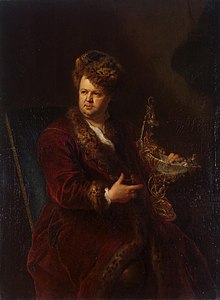Dinglinger's vineyard
Dinglingers Weinberg is a listed vineyard property in Dresden . It is named after its previous owner, court jeweler Johann Melchior Dinglinger (1664–1731), one of the richest citizens of Dresden of his time.
geography
The vineyard is located in the Loschwitz district , coming from the city center before the original location, in terraces on the Elbe slope . It is bounded in the west by the Mordgrund , to the northwest of this are the three Elbe castles . To the east of the Mordgrundbach , Dinglinger had to maintain a hunting path, today the Heilstättenweg leads there from the Elbe up the slope to Wunderlichstraße, which merges into the southeast running Schevenstraße at the property entrance. The southern border on the Elbe is formed by the Körnerweg, which runs almost parallel to Schevenstrasse at this point .
In the northern part of the approximately two-hectare property is the Landhaus (Schevenstraße 59, formerly Carolastraße 37), built in the corner and protected as a cultural monument, with a pavilion on a forward terrace to the southwest. Another pavilion is located on the eastern property line. Both pavilions are also designated as cultural monuments. The separate properties at Schevenstrasse 49 and 51 have been left out of the area of the Dinglingers Weinberg garden monument .
history
In addition to his splendid town house in Frauengasse on Neumarkt , "which, like no other of its time, preserved the character of a human spirit exploring heaven and earth," Johann Melchior Dinglinger acquired the property on the Elbe slope near Loschwitz around 1700. Dinglinger had the half-timbered winegrower's house built in the first half of the 17th century expanded with a baroque, sandstone south wing. The largest room in the house is a hall facing the Elbe. On the ceiling there is a painted compass rose on which pointers, which are connected to the weather vane on the roof with a mechanism made around 1710 by Hofmechanikus Andreas Gärtner , indicate the weather, wind direction and strength. When Tsar Peter the Great visited Dinglinger's house in 1711, he was so impressed by the equipment that he had a copy made for him, which is still preserved today in Saint Petersburg.
The Dresden court painter Christian Benjamin Müller (1690–1758) etched a landscape with Dinglinger's vineyard.
The merchant Jean Souchay acquired the property in 1859. Around 1880, the consul Bruno Wunderlich , who in 1883 also bought the neighboring Eckberg Castle , acquired the property. His widow chose Dinglinger's vineyard as a widow's residence. The heirs sold the vineyard property to the von Watzdorf family .
Almost two centuries after Dinglinger's death, the position of Dinglinger's vineyard seems to have been forgotten. In his description of the buildings in 1904 , Cornelius Gurlitt referred to the ceiling construction and referred to “the same facility in the Dinglinger house” in the city, but did not draw any conclusions about the previous owner. On the basis of a certificate issued in 1725 regarding the extension of the vineyard by a narrow strip at the Mordgrund at Dinglinger's request and by the Prince-Elector August II , Erna von Watzdorf was able to "now localize Dinglinger's vineyard with accuracy."
After the Second World War and in the GDR, the house, which belonged to a widespread community of heirs, survived the land reform and nationalization. From 1955 until his death in 2005 , the conservationist Hans Nadler rented the house, which he actively saved from deterioration. From 1995 there was an ideological debate about the planned takeover of the property by a Dresden-based notary from the heirs, which included Deutsche Bank board member Carl Ludwig von Boehm-Bezing . After several years of building-historical investigations, the renovation of the residential building in accordance with the listed buildings began in 2004, during which the partition walls were removed and the main entrance was moved back to its original location. In the meantime, the vineyard has been restored and tanned. The first harvest took place in 2002. In 2014, the owner couple in Lower Saxony bought a sandstone fountain from Dinglinger's time and had it set up in front of the house.
Footnotes
- ↑ Erna von Watzdorf : Dinglinger's vineyard near Loschwitz . In: Dresden history sheets . 48th year, 1940, p. 57 ( digitized version of the SLUB Dresden ).
- ↑ Bettina Klemm, Steffen Füssel: The rebirth of Dinglinger's vineyard - impressions of Dinglinger's vineyard. In: Sächsische Zeitung online. Retrieved on April 10, 2020 (Image 3 of 6).
- ↑ Anke Fröhlich: Müller, Christian Benjamin . In: Institute for Saxon History and Folklore (Ed.): Saxon Biography .
- ^ Georg Kaspar Nagler : New general artist lexicon . tape 9 . E. A. Fleischmann, Munich 1840, p. 547 f . ( Digitized version ).
- ↑ Schevenstrasse. In: dresdner-stadtteile.de. Retrieved July 1, 2018 .
- ↑ Cornelius Gurlitt : Die Kunstdenkmäler von Dresdens Umgebung, Part 2: Amtshauptmannschaft Dresden-Neustadt (= Descriptive representation of the older architectural and art monuments of the Kingdom of Saxony . Volume 26 ). Meinhold, Dresden 1904, p. 93 ( digitized version of the SLUB Dresden ).
- ↑ Erna von Watzdorf : Dinglinger's vineyard near Loschwitz . In: Dresden history sheets . 48th year, 1940, p. 55 ( digital version of the SLUB Dresden ).
- ↑ Ullrich Fichtner : Vineyard of discord . In: The time . No. 14 , 2001 ( online ).
- ↑ Bettina Klemm: A fountain gushes again on Dinglinger's vineyard. In: Saxon newspaper. April 21, 2014, accessed April 10, 2020 .
Web links
Coordinates: 51 ° 3 ′ 43 ″ N , 13 ° 48 ′ 7.5 ″ E


